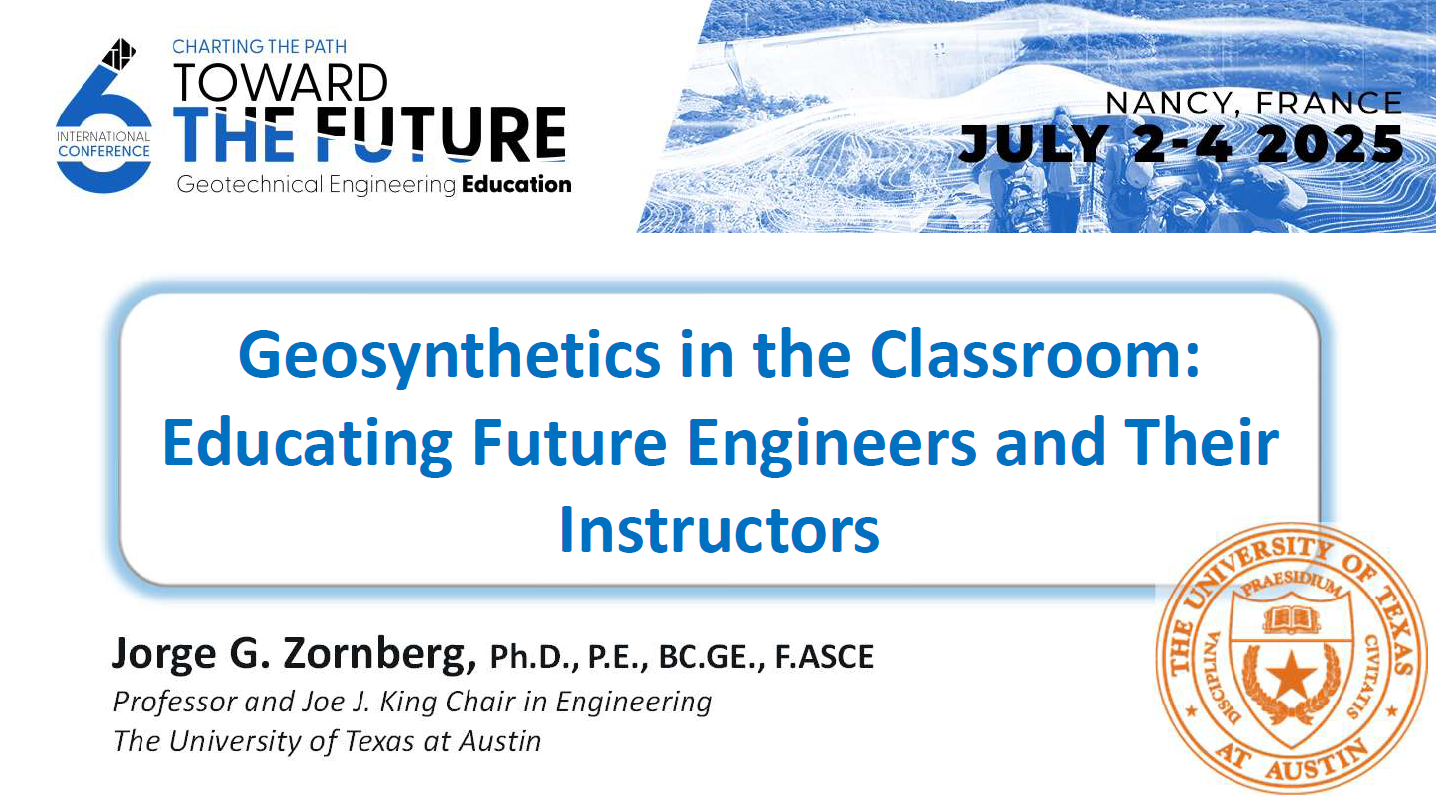About
Geosynthetics in the classroom: Educating future engineers and their instructors
Geosynthetics are geomaterials now widely used across nearly all areas of geotechnical engineering. Despite their growing importance in practice, instruction on geosynthetics remains limited in undergraduate civil engineering programs. While their teaching is becoming more established at the graduate level and in continuing education for professionals, undergraduate curricula have yet to reflect this shift. One reason for this gap is that many current geotechnical faculty were not exposed to geosynthetics during their own education, given the relatively recent emergence of these materials. Although professional training may eventually address practical applications, exposure to the fundamental behavior of geosynthetics arguably belongs alongside that of traditional geomaterials, early in the educational process. Embedding this content at the undergraduate level helps ensure that students develop a comprehensive understanding of geomaterials from the outset.
This presentation introduces core concepts that align the teaching of synthetic geomaterials (geosynthetics) with that of earthen geomaterials such as soils and rocks. It begins by presenting educational modules that draw parallels between geosynthetics behavior and basic principles of soil mechanics. To support university professors in bringing this content into undergraduate civil engineering classrooms, the International Geosynthetics Society (IGS) launched an educational initiative. This program facilitated in-depth discussions around technical content, instructional delivery, and the challenges of introducing new material into already crowded undergraduate curricula. It also offered a valuable opportunity to assess how seasoned educators engage with emerging teaching content.
The presentation concludes with the results of a survey conducted among civil engineering faculty at universities in several countries. The goal was to assess how geosynthetics are currently taught at the undergraduate level and to identify gaps and opportunities. More broadly, it provides insights into the structure of civil engineering curricula by examining the number and nature of required versus elective courses in geotechnical engineering across representative national contexts.
Together, these insights highlight the importance and feasibility of integrating geosynthetics meaningfully into core civil engineering education, ensuring students are better prepared for modern geotechnical practice.
Presentation Slides: Zornberg-GEE_2025.pdf
Presenter
Jorge G. Zornberg
Jorge G. Zornberg has over 35 years of experience in practice and research in geotechnical and geosynthetics engineering. His research focuses on transportation geotechnics, environmental geotechnics, geosynthetics, unsaturated soils, and expansive clays. As an engineering consultant, he has been an expert witness in litigation and forensic geotechnical cases. From 2010 to 2014, Prof. Zornberg served as president of the International Geosynthetics Society (IGS). He has authored over 500 technical publications, written several book chapters, and been awarded three patents. Prof. Zornberg received numerous prestigious awards, including the 2024 Peck Lecture Award. He was also recognized with the Mercer Lecture, ASCE’s Croes Medal, the IGS Award, ASCE’s Collingwood Prize, as well as the Presidential Early Career Award for Scientists and Engineers (PECASE) awarded by the President of the United States. In 2019, the IGS established the “Zornberg Lecture,” an honorary lecture recognizing his contributions to the discipline of geosynthetics.



![2nd John Burland Lecture: Reflections on Some Contemporary Aspects of Geotechnical Engineering Education - From Critical State to Virtual Immersion {"category":"webinar","subjects":["Education"],"number":"GEE2020-1","instructors":["Mark Jaksa"]}](/asset-v1:ISSMGE+GEE2020_1+2020+type@asset+block@Jaksa-Intro-Slide.jpg)
![Forks in the Road: Rethinking Modeling Decisions that Defined Teaching and Practice of Geotechnical Engineering {"category":"webinar","subjects":["Education"],"number":"GEE2020-2","instructors":["Rodrigo Salgado"]}](/asset-v1:ISSMGE+GEE2020_2+2020+type@asset+block@Salgado-Intro-Slide.jpg)
![Prior Knowledge, Learning and Common Instructional Practices Grounded in Evidence {"category":"webinar","subjects":["Education"],"number":"GEE2020-3","instructors":["Susan A. Ambrose"]}](/asset-v1:ISSMGE+GEE2020_3+2020+type@asset+block@Ambrose-Intro-Slide.jpg)
![Basic Geotechnical Engineering Skills What Can Graduated Do? (First John Burland Lecture) {"category":"honour_lecture","subjects":["Education"],"number":"HJBL101","instructors":["John Atkinson"]}](/asset-v1:ISSMGE+HJBL101+2016+type@asset+block@1475823575-John-Atkinson-Webinar.jpg)
![Soil-Bentonite Slurry Trench Wall Lateral Deformation, Consolidation, and State-of-Stress {"category":"webinar","subjects":["Education"],"number":"TC211-03","instructors":["Jeffrey Evans"]}](/asset-v1:ISSMGE+TC211-03+2024+type@asset+block@SB_Photo.jpg)
![Geo-Engineering Education {"category":"course","subjects":["Teaching Geotechnics"],"number":"VU-GE","instructors":["John Atkinson","Lawrence Wesley","Carlo Viggiani","Marina Pantazidou"]}](/asset-v1:ISSMGE+TC306-001+2019+type@asset+block@Intro-Slide-Wesley.jpg)
![3rd John Burland Lecture | Changing attitudes, organization and scale in engineering education: The teacher as a go-between and TC306 as a knowledge broker {"category":"honour_lecture","subjects":["Education", "Teaching Geotechnics"],"number":"TC306-GEE2025-01","instructors":["Marina Pantazidou"]}](/asset-v1:ISSMGE+TC306-GEE2025-01+2025+type@asset+block@pantazidou.png)
![Urgent questions for engineering education in the age of GenAI: knowledge, teaching, & assessment {"category":"honour_lecture","subjects":["Education"],"number":"TC306-GEE2025-02","instructors":["Jennifer Case"]}](/asset-v1:ISSMGE+TC306-GEE2025-02+2025+type@asset+block@case.png)
![Teaching numerical methods or teaching with numerical methods? {"category":"talk","subjects":["Numerical Analysis", "Teaching Geotechnics"],"number":"TC306-GEE2025-03","instructors":["Francesca Ceccato"]}](/asset-v1:ISSMGE+TC306-GEE2025-03+2025+type@asset+block@ceccato.png)
![New challenges in rock mechanics: Building new skills in engineering education {"category":"talk","subjects":["Education"],"number":"TC306-GEE2025-04","instructors":["Jean Sulem"]}](/asset-v1:ISSMGE+TC306-GEE2025-04+2025+type@asset+block@sulem.png)
![Undergraduate teaching of Unsaturated Soil Mechanics: Building on fundamental physical mechanisms to pave the way for geotechnical analyses {"category":"talk","subjects":["Teaching Geotechnics", "Soil Mechanics"],"number":"TC306-GEE2025-05","instructors":["Alessandro Tarantino", "Alessia Amabile"]}](/asset-v1:ISSMGE+TC306-GEE2025-05+2025+type@asset+block@tarantino-amabile.png)
![What role should software play in geotechnical education? {"category":"talk","subjects":["Education", "Numerical Analysis"],"number":"TC306-GEE2025-06","instructors":["Nicolas Utter"]}](/asset-v1:ISSMGE+TC306-GEE2025-06+2025+type@asset+block@utter.png)